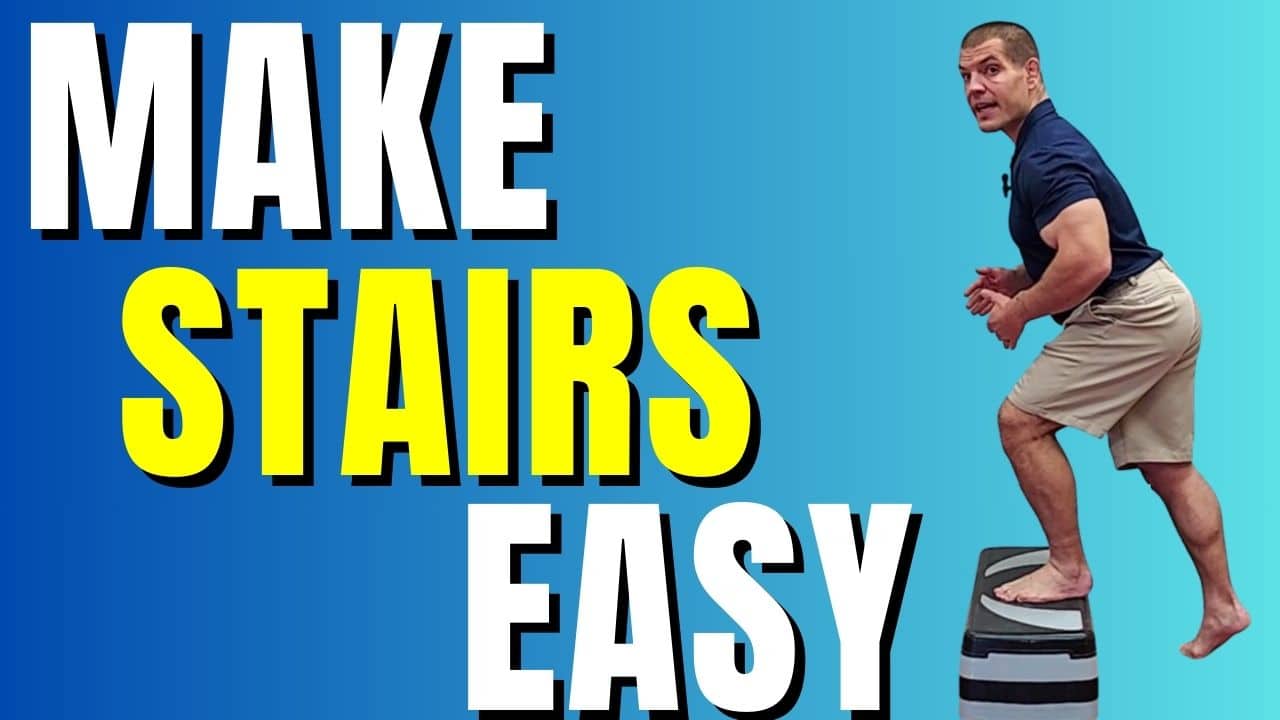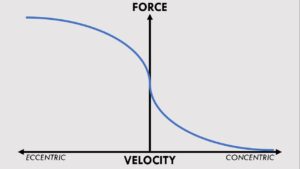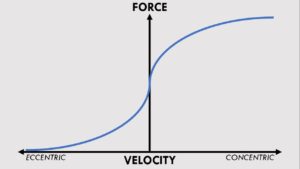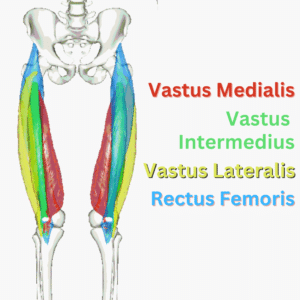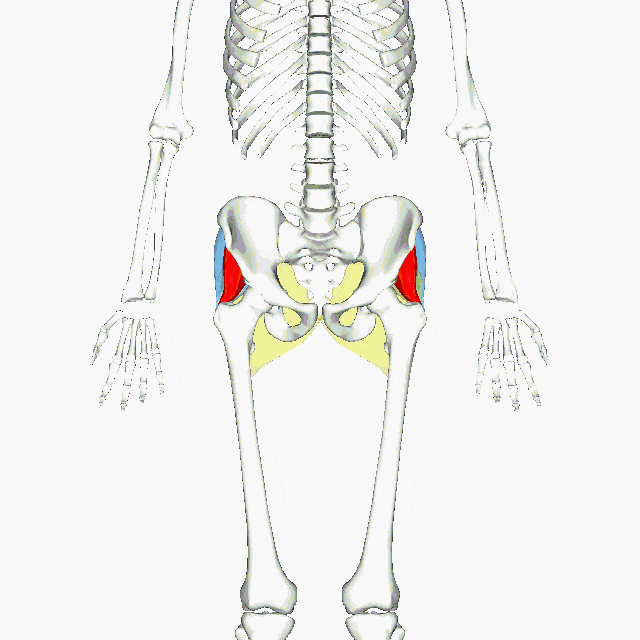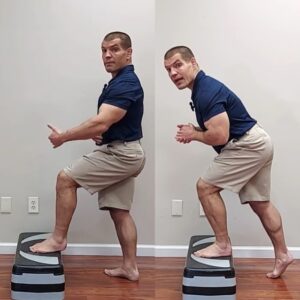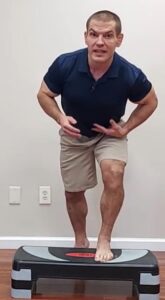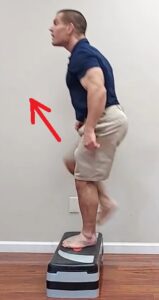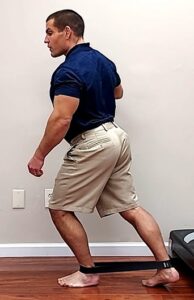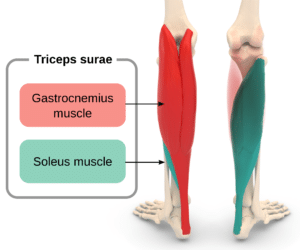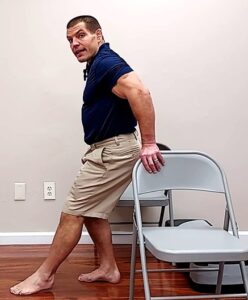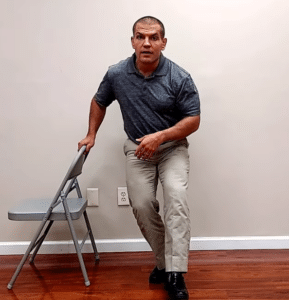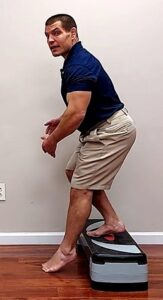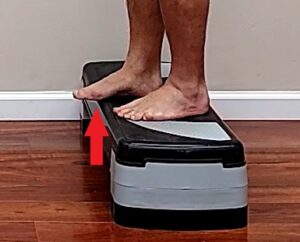Do You Have Difficulty Climbing Stairs or Walking Down Stairs?
Many older adults have difficulty climbing stairs, or worse, falling when walking down stairs.
Sometimes these problems become so severe that it causes them to leave their long-time homes due to pain or safety concerns on stairs.
But it doesn't have to be that way!
Watch this video to learn practical tips, tricks, and exercises to make it easier to walk up and down stairs.
Climbing Stairs vs. Walking Down Stairs
Going up and going down stairs can both pose difficulties.
Although they seem like similar activities, walking up and walking down stairs are unique activities. Therefore, each present their own challenges.
When climbing stairs, you have to overcome the downward force of gravity to accelerate your body upwards.
Conversely, when you're walking down stairs, gravity is doing the work of bringing you down. You're just producing force with your muscles to slow down the effect of gravity.
The Force-Velocity Curve
There's something used in strength training known as the force-velocity curve.
Essentially what that says is that you can:
- Eccentrically lower more weight than you can lift concentrically
- Lower more weight quickly than you can lower slowly
- Lift more weight slowly than you can quickly
However, that's considering an external resistance like a weight when you're doing a bicep curl.
When you're lifting the constant resistance of your body at varying speeds against the downward force of gravity, the curve flips upside down.
Gravity is producing a constant downward acceleration of 9.8 meters per second per second.
To hold your body statically off the floor, static position, you have to produce an equal and opposite force to accelerate you upwards at 9.8 meters per second per second.
If you produce slightly higher than the force of gravity, you move up slowly. If you produce much more force than gravity, then you move up quickly.
Conversely, if you produce slightly less force than the gravitational force, you move down slowly. If you produce a lot less force than gravity, you move down quickly. If you produce no force, you free fall.
Difficulty Climbing Stairs vs. Walking Down Stairs
Walking up stairs requires more force production, so usually difficulty climbing stairs indicates is a strength problem.
Conversely, difficulty walking down stairs usually is not a strength problem as much as an ankle mobility problem.
Additionally, difficulty walking down stairs may be due to an inability to control your leg on a side-to-side plane as you eccentrically lower your bodyweight.
First, we'll cover tips, tricks, and exercises to help you climbs stairs more easily. Then, we'll cover tricks to go down the stairs more easily.
How To Climb Stairs More Easily
Again, going upstairs is usually a force production problem.
You use a combination of your quadriceps and your glutes to lift your body up a stair.
Placing Your Foot When Climbing Stairs
We'll first start with how you place your foot on the stair.
How you place your foot affects what muscle groups you use.
If you just place the ball of your foot on the step and press up, you're going to use primarily your quadriceps.
Conversely, if you place your whole foot on the step and push through your heel, you use a combination of quadriceps and glutes.
So when placing your foot to climb stairs, try to get your whole foot on the stair.
Stacking Your Bodyweight
Next, lean your body weight out over your foot so that your center of gravity lines up over your foot.
If you're trying to climb stairs standing upright, it's a much longer lever arm versus if you lean into the slant of the staircase.
When you stack your center of gravity over your foot, and the lever arm is much shorter. This makes it easier to climb stairs.
You can also use that forward lean to create momentum when you step up onto the next stair. I'll discuss that further later in this post.
Frontal Plane Alignment When Climbing Stairs
Looking from a front view, you want to make sure you have your hip, knee, and foot all in alignment when climbing stairs.
Weakness in the gluteus medius and gluteus minumus muscles can cause your knee to drift inward when climbing stairs.
In order to make it easier to climb stairs, think about turning your knee out slightly and putting the weight through the outer side of your heel.
Doing this will help activate your glutes.
Exercise For Difficulty Climbing Stairs
What about exercises to help with difficulty climbing stairs?
If you think back to the force-velocity curve that I mentioned earlier, it's easiest to go up the stairs slowly. The faster you go up, the more force it requires.
So we'll start right in the middle of the curve doing an isometric strengthening exercise and then progress to a concentric exercise from there.
Start with your whole foot out on the step with your weight slightly to the outside of the heel.
JungleA 31" Exercise Step Platform For H...
40% OffNext, lean forward stacking your body weight over your foot.
This is going to be the starting position for the exercise.
Now just press your heel down into the stair just enough that you're feeling your glute muscles and quad muscles activate.
Then, slowly lift yourself up off the floor.
As more and more of your body weight leaves the floor, you take more and more force to the point where you have 100% of your weight over your leg.
The bottom position is the hardest part of the movement because the lever arm of gravity is the greatest in this position.
Again, you're trying to minimize that by stacking your body weight, but it's still the hardest at the bottom and gets easier as your leg gets more vertical.
After you can do an isometric hold for 5 seconds, then you're ready to move on to a concentric motion.
Slowly start to step up keeping the weight through the outer side of the heel and your knee over your toe.
If you need to hold on to something for balance, feel free to do so.
Go up the stair slowly, and then slowly come back down.
So this exercise works in the middle of the force-velocity curve with a slow concentric movement followed by a slow eccentric movement.
Practical Tips For Climbing Stairs
Practically though, when you're climbing stairs, you want to do it quickly.
You can use momentum to help propel you from one step to the next.
Rather than thinking about climbing one stair at a time, think about stepping through the stair.
That way, you can use your momentum to keep you going rather than starting from a static position each time.
Additionally rather than thinking about lifting your body up the stair, think about using your foot to press the stair down and slightly backward.
How To Walk Down Stairs More Easily
Next, we'll move on to tips to help you with going down the stairs.
Remember, going down the stairs is less of a strength problem because gravity is actually taking you downwards.
It's more of an ankle mobility problem, being able to get your knee out over your toe while keeping your heel flat on the ground.
This motion is known as ankle dorsiflexion.
To help improve ankle dorsiflexion, put an elastic resistance loop around your ankle.
You'll put the band around one ankle and then around the other ankle.
Exercise Bands Set,Resistance Band with ...
23% OffStagger your feet to put a little stretch on the band.
Then move your front knee in front of your toes.
The ankle kind of helps improve your ankle joint mobility while also stretching a calf muscle known as the soleus.
Repeat 10 to 15 times on one leg and then 10 to 15 times on the other leg.
After you've improved the mobility of your ankle, we next want to work on eccentric control.
Exercises For Eccentric Control When Walking Down Stairs
It's easiest and safest to practice on the ground because the motion we're going to be using during this exercise is the same as stepping down.
Stand on one leg, holding on to something as needed for balance.
Slide one foot forwards while doing a little mini squat on the back leg.
To see that from the front, you're going to try to maintain a neutral alignment from hip to knee to ankle.
Slide the front foot forward as far as you can reach safely.
This is very similar to the motion that you use when going downstairs, but you don't have the safety factor of potentially falling off the stair.
Once you've mastered doing the exercise on the ground, you can now start to do it stepping down from a stair.
Again, hold on to something for balance if you need to.
If you have one of these aerobic steps, you can adjust the height to make it easier if you can't get down a full height step.
JungleA 31" Exercise Step Platform For H...
40% OffQuick Trick To Make Walking Down Stairs Easier
Finally, what do you do if you need to improve your ability to go downstairs today?
The tips above take some time to improve mobility and strength.
But think back to the force-velocity curve.
Gravity is going to do most of the work for you. If you do absolutely nothing, gravity is going to lower you down the stairs.
If you place your toes just slightly over the edge the stair, then you don't need as much mobility in your ankle.
You can kind of roll over the edge.
You don't need as much eccentric control because you're basically just going to drop and catch yourself on the other leg.
So that's a quick tip, a little hack if you need to improve your ability to walk down stairs quickly. This is particularly good if you get knee pain when going downstairs. Place the toes over the edge, roll, and drop.
Hopefully, this post was helpful to give you less pain, more safety, and more confidence when walking up and down stairs.
Need Help To Walk Up and Down Stairs More Easily?
If you live in the St. Louis and need help to walk up and down stairs safely, confidently, and without pain, just tap the button below to request an appointment with one of our specialist physical therapists.
Like this post? Here are some others you may enjoy:
How To Fix Your Knee Pain Going Up And Down Stairs In Just A Few Seconds
Pain Under The Knee Cap? Simple Tips For Pain-Free Stairs & Squatting
Hip Pain Climbing Stairs? 6 Tips To Relieve Pain In Hip Going Up Stairs
Fix Kneecap Pain Walking Up Stairs Even If You Have Patellofemoral Degenerative Arthritis
Relieve Knee Pain Climbing Stairs Instantly With These 2 Easy Tips

